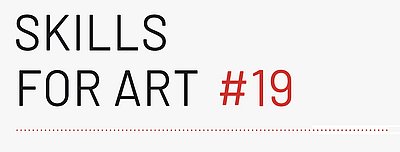Welcome at the Interface Culture program website.
Acting as creative artists and researchers, students learn how to advance the state of the art of current interface technologies and applications. Through interdisciplinary research and team work, they also develop new aspects of interface design including its cultural and social applications. The themes elaborated under the Master's programme in relation to interactive technologies include Interactive Environments, Interactive Art, Ubiquitous Computing, game design, VR and MR environments, Sound Art, Media Art, Web-Art, Software Art, HCI research and interaction design.

The Interface Culture program at the Linz University of Arts Department of Media was founded in 2004 by Christa Sommerer and Laurent Mignonneau. The program teaches students of human-machine interaction to develop innovative interfaces that harness new interface technologies at the confluence of art, research, application and design, and to investigate the cultural and social possibilities of implementing them.
The term "interface" is omnipresent nowadays. Basically, it describes an intersection or linkage between different computer systems that makes use of hardware components and software programs to enable the exchange and transmission of digital information via communications protocols.
However, an interface also describes the hook-up between human and machine, whereby the human qua user undertakes interaction as a means of operating and influencing the software and hardware components of a digital system. An interface thus enables human beings to communicate with digital technologies as well as to generate, receive and exchange data. Examples of interfaces in very widespread use are the mouse-keyboard interface and graphical user interfaces (i.e. desktop metaphors). In recent years, though, we have witnessed rapid developments in the direction of more intuitive and more seamless interface designs; the fields of research that have emerged include ubiquitous computing, intelligent environments, tangible user interfaces, auditory interfaces, VR-based and MR-based interaction, multi-modal interaction (camera-based interaction, voice-driven interaction, gesture-based interaction), robotic interfaces, natural interfaces and artistic and metaphoric interfaces.
Artists in the field of interactive art have been conducting research on human-machine interaction for a number of years now. By means of artistic, intuitive, conceptual, social and critical forms of interaction design, they have shown how digital processes can become essential elements of the artistic process.
Ars Electronica and in particular the Prix Ars Electronica's Interactive Art category launched in 1991 has had a powerful impact on this dialog and played an active role in promoting ongoing development in this field of research.
The Interface Cultures program is based upon this know-how. It is an artistic-scientific course of study to give budding media artists and media theoreticians solid training in creative and innovative interface design. Artistic design in these areas includes interactive art, netart, software art, robotic art, soundart, noiseart, games & storytelling and mobile art, as well as new hybrid fields like genetic art, bioart, spaceart and nanoart.
It is precisely this combination of technical know-how, interdisciplinary research and a creative artistic-scientific approach to a task that makes it possible to develop new, creative interfaces that engender progressive and innovative artistic-creative applications for media art, media design, media research and communication.
SVS und KSVF
20. Jänner 2026, 14.00 Uhr Kunstuniversität Linz, Hauptplatz 6, 5. Stock, Hörsaal D und online
Nach dem Input der Vortragenden haben Teilnehmer*innen die Möglichkeit, Fragen zu stellen. Die Veranstaltung findet in deutscher Lautsprache statt. Fragen können auch auf Englisch gestellt werden.
Moderation: Daniela Koweindl (IG Bildende Kunst)
Teil 1: SVS
Vortragender: Gregor Wurzinger (SVS)
Die Pflichtversicherung für Selbstständige gilt, wenn die Jahreseinkünfte über der Versicherungsgrenze liegen (2025 sind das 6.613,20 Euro). Dann gibt es das Gesamtpaket, also inklusive Pensionsversicherung.
Was kostet das, was deckt die Pflichtversicherung bei der Sozialversicherung der Selbstständigen (SVS) sonst noch alles ab? Und wie komme ich zu einem Versicherungsschutz, wenn ich voraussichtlich weniger als diese 6.613,20 Euro verdiene?
Wir sprechen über Versicherungsgrenzen, Mindest- und Höchstbeiträge, vorläufige und endgültige Beitragsvorschreibungen. Auch die freiwillige Selbstversicherung (Opting In) sowie Befreiung von Selbstbehalt und Rezeptgebühr werden Thema sein. Und: Was tun bei Zahlungsschwierigkeiten?
Teil 2: KSVF
Vortragend: [tbd] (KSVF)
Bis zu 1.896 Euro jährlich kann der Künstler:innensozialversicherungsfonds (KSVF) an Zuschuss zu den Sozialversicherungsbeiträgen von selbstständig tätigen Künstler*innen leisten. Welche Voraussetzungen muss ich dafür erfüllen? Wie lange rückwirkend kann ich den Zuschuss für die Vergangenheit beantragen, wie kann ich ihn für Folgejahre fortlaufend beziehen?
Ein Schlaglicht werfen wir diesmal auf die Frage: Was gilt (nicht) als künstlerische Tätigkeit beim KSVF? Und wer entscheidet darüber? Künstler*innenkommissionen – mit Vertreter*innen von Künstler*innenverbänden – werden einberufen, um Gutachten zu erstellen. Wie läuft das ab? Welche Unterlagen sind hierfür wann erforderlich? Wie lege ich meine künstlerische Arbeit hierfür idealerweise dar?
Last but not least: Es gibt im KSVF auch einen Unterstützungsfonds für Künstler*innen in Notsituationen. Außerdem ist der KSVF zuständig für Ruhendmeldungen der künstlerischen Tätigkeit (vorübergehende Ruhendmeldung/Ausnahme aus der Pflichtversicherung) sowie für das Einheben von Abgaben, um den Zuschuss zu finanzieren.
Abschließend laden wir alle Teilnehmer*innen ein, noch ein wenig zu bleiben und sich bei einer Erfrischung zu informieren und auszutauschen.
__________________________________________________________________________________
Anmeldung erforderlich: https://forms.office.com/e/w38rQiYJtu
__________________________________________________________________________________
Veranstaltet von: IG BILDENE KUNST, forum – Kunstuniversität Linz , FIFTITU%
__________________________________________________________________________________
Infomaterial der IG BILDENDE KUNST zu diesem Thema:
KSVF
SVS
__________________________________________________________________________________
Zu skills for art
In einem für Berufstätige praktikablen Zeitausmaß bieten wir Unterstützung für Kunstschaffende, die ihre Kenntnisse über die Selbständigkeit und diverse Aspekte einer Projekterstellung und -präsentation auffrischen, erweitern und vertiefen wollen.
